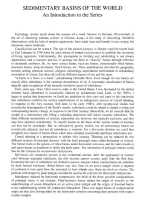Добрый день, Коллеги. Важное сообщение, просьба принять участие. Музей Ферсмана ищет помощь для реставрационных работ в помещении. Подробности по ссылке
Sedimentary basins of the world: An introduction to the series / Осадочные бассейны мира: введение в серию
Etymology reveals much about the essence of a word. Science in German, Wissenschaft, is the art of observing whereas science in Chinese, koxue, is the study of classifying. Scientific observations, with the help of modern equipments, have made leaps and bounds in our century, but taxonomy seems irrelevant.
Classification can be science. The rise of the natural sciences in Europe could be traced back to Carl Linnaeus in 1750 when he used criteria of mutual exclusiveness to establish the taxonomy of living organisms. Unfortunately, this prerequisite in dividing and subdividing is not always appreciated, and a common practice in geology has been to "classify" basins through reference to incidental attributes. So, we have coastal basins, back-arc basins, extensionally rifted basins, uccessor basins, deep-sea basins, flysch basins, etc. These qualifications describe the geography, tectonic setting, principal stresses, orogenic chronology, depositional environment or sedimentary association of a basin, but these all could be different aspects of one and the same.
"A basin is a basin is a basin", paraphrasing Gertrude Stein. Even though no two basins are exactly alike, subsidence is the common denominator of all. A systematic classification of basins depends upon recognition of the mutually exclusive causes of subsidence.
Forty years ago, when I first went to study in the United States, I was fascinated by the debate whether basin subsidence is isostatically induced by sedimentary load. Later, in the 1950's, I began to realize that depressions on Earth are underlain by thin crust and came to the conclusion that subsidence could be the surface manifestation of an endogenetic process of crustal thinning, in response to the Airy isostasy. Still later, in the early 1960's, after geophysical studies had revealed the heterogeneity of the Earth's mantle, subsidence could be related to mantle cooling and corresponding density change, in response to the Pratt isostasy. Meanwhile, we all concede that the weight of a sedimentary pile filling a subsiding depression will induce isostatic subsidence. The three different mechanisms of isostatic adjustment are, however, not mutually exclusive, and they may have operated concurrently. To classify basins on the basis of the various modes of isostasy can thus not be systematic. But, as indicated by gravity studies, not all sedimentary basins are isostatically adjusted, and not all subsidence is isostatic. For a first-order division we could thus recognize two classes of basins, those which have subsided isostatically and those which have not. Crustal thinning is a prerequisite to initiate Airy isostasy. Thinning can be induced by two different systems of principal stresses, with the least principal stress either horizontal or vertical. The former leads to the genesis of rifted basins under horizontal extension, and the latter results in pull-apart basins in transform or strike-slip fault zones. The orientation of principal stresses could thus be the criterion for second-order distinctions. <...>




